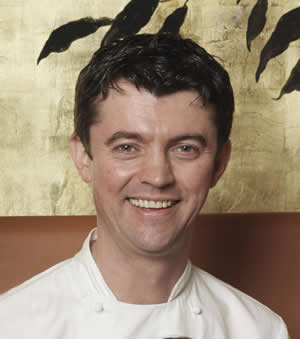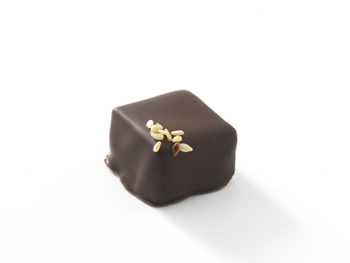If you are looking for a Valentine's Day gift with a bit of a twist - why not be inspired by flavours from Japan? We spoke to London-based chocolatier William Curley to find out more about his unique blends of chocolate with traditional Japanese ingredients, and the inspiration behind them.
|
Can you tell us about your background and the main stages of your career?
I began my career with an apprenticeship at Gleneagles Hotel, I then went on to spend seven years at numerous Michelin starred establishments including L'Esperance in France, La Tante Claire, Le Manoir aux Quat'Saisons and the Oak Room with Marco Pierre White. I subsequently became Chef Patissier at The Savoy, where I met my wife Suzue.
When did you become particularly interested in chocolate and why?
I developed my interest in chocolate during my time at Gleneagles. They had a little chocolate section which was part of the pastry area. About half-way through my second year working at Gleneagles I was put on the chocolate section and I loved it. It was nothing like those in hotels, kitchens and restaurants today - it was mainly making truffles, turndown chocolates or chocolates for the rooms and chocolate decorations - I think we only had two types of dark chocolate and milk and white to use! Everyone was always keen to work in the chocolate section of the kitchen!
|

|
Chocolate is not a typical ingredient in Japanese cooking. When did you first think of fusing Japanese flavours with chocolate and what was the first fusion that you tried?
The chocolate market has expanded greatly in Japan over the years - I have noticed the expansion since we opened our Richmond shop in 2004. The Japanese have certainly started to appreciate chocolate in its finest form. The experimental side of me drove me to use different, unusual flavours, and my travels to Japan and obviously Suzue's heritage opened up a world of different and extraordinary Japanese ingredients and flavours to experiment with. While eating at various establishments in Japan, I was served flavour combinations that I would not necessarily have thought of putting together - this led to my curiosity and then attempting to try out certain Japanese flavours and ingredients with chocolate and patisserie.
Suzue and I are both inspired by Japanese ingredients, Suzue introduces them to me and I work on creations that complement our chocolate and patisserie. As a business we love the Japanese influence and making things look precise and sharp, which are both huge parts of this influence - Suzue is best at this part of the creation process!
Suzue gets the ingredients sent over and then my curiosity and creative streak take over. The first Japanese inspired fusion I tried was yuzu - a Japanese citrus fruit - we use this in many creations now - chocolates, patisserie, desserts - it is delicious and goes extremely well with chocolate. I first discovered yuzu in a local restaurant in Osaka - it was served in a panna cotta¡Ä delicious.
|

Curley's Toasted Sesame Couture chocolate
|
You use some very interesting flavours such as wasabi and black vinegar, which ordinarily would not be associated with chocolate. Where do you get your inspiration for such mixtures and how difficult was it to use those ingredients to produce something that tasted good?
I gain all my inspiration from visits to Japan and from Suzue. The Japanese influences and ingredients we use (toasted sesame, yuzu, Japanese black vinegar) in our creations are really the speciality and trademark of what we do as a business. This trademark makes us stand out from many other chocolatiers and patisserie shops. The Japanese angle is purely ours for our own creations; I don¡Çt know any others in London doing the same as us.
What do you consider to be your greatest Japanese inspired creation?
I think our Japanese Black Vinegar Couture Chocolate - this is a hugely popular chocolate - it has won many awards and is a very unusual flavour combination that works really well.
|
Are there any Japanese flavours that you would like to use but have found particularly challenging to blend with classic ingredients? How about trying an umeboshi (pickled plum) chocolate?!
I have actually tried to use umeboshi!! Unfortunately it just didn¡Çt work - it is too salty. In theory it should work though! Plum goes well with chocolate generally. Another is seaweed - I am determined to make this work and have recently received a few different types of seaweed - all of my previous attempts have failed as I just can¡Çt seem to get rid of the taste of fish - it will work eventually, I am sure!
Other flavours I am experimenting with at the moment are soya, Japanese honey and fresh wasabi - we do apricot and wasabi already and it is very popular but I think fresh wasabi truffles will be a huge success. I have managed to find a UK supplier of fresh wasabi, which makes the process much easier!
In contrast to the UK, the widely spread practice on Valentine¡Çs Day in Japan is for women to give chocolate to men. At this time of year, chocolate products are promoted in a way to make them more appealing to male customers. In your experience, are there any particular chocolate flavours which appeal more to men?
The chocolate market at Valentine's is driven by a female audience. When I am creating chocolates I do have a female audience at the back of my mind. I would say our customers are split 70% female to 30% male. The more manly products we create are things such as the Yamasaki Whisky Truffles - which are a more masculine product, and men tend to appreciate them. We don¡Çt make a separate male and female range of chocolates though - anyone can enjoy them! Certain chocolates we produce are obviously more feminine - like lavender flavoured chocolates and framboise truffles.
As you share marketing experience in both Japan and the UK, what are the most popular kinds of chocolate in each country and how do you analyse the differences?
In London we are lucky as the customers are willing to try unusual flavour combinations - they are very experimental. Japan, I feel, is on the cusp of this willingness of the consumer to experiment. The majority of our Japanese customers in the UK are driven to buy through curiosity - which works for me! The Japanese tend to buy more patisserie than chocolates, although Japanese men buy more chocolates than British men.
Do you think that we will see more crossovers with classic and Japanese flavours as people become more familiar with Japanese ingredients? Which particular ingredients or flavours would you encourage people to experiment with?
Our trademark is our Japanese influence, especially the Japanese black vinegar. Japanese ingredients have been around for a while - things like sesame, a very forgiving flavour, a great flavour - it works very well with chocolate and patisserie. Many more British-born chefs are creating French food with a Japanese influence these days. For example, Pierre Herme who has a Japanese influence and like me, has built knowledge and understanding from visits to Japan. Each time you go there you pick up more ideas and inspiration.
All chefs should be encouraged to try Japanese flavours - experiment! If you feel creative, then go for it! |
|

